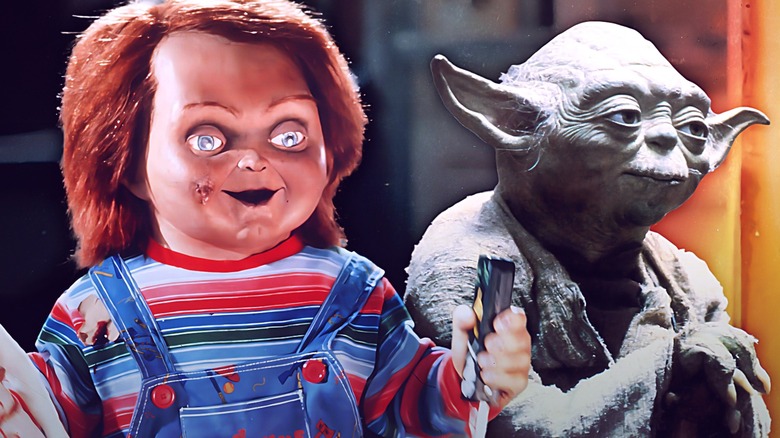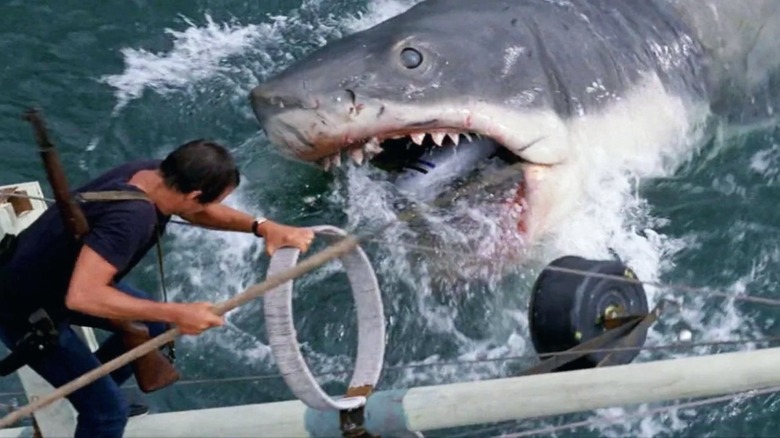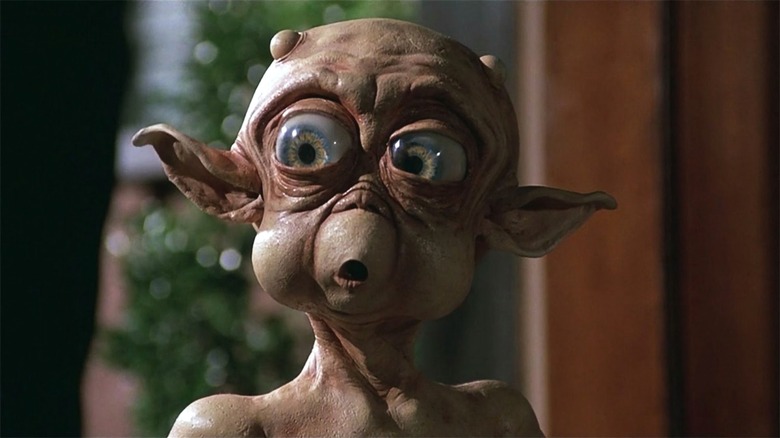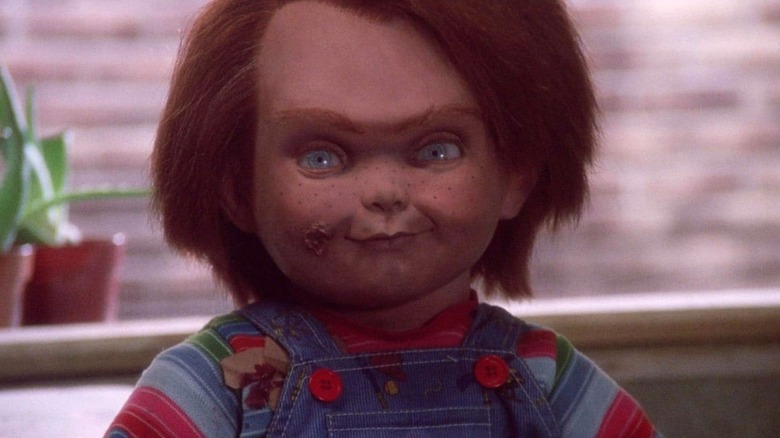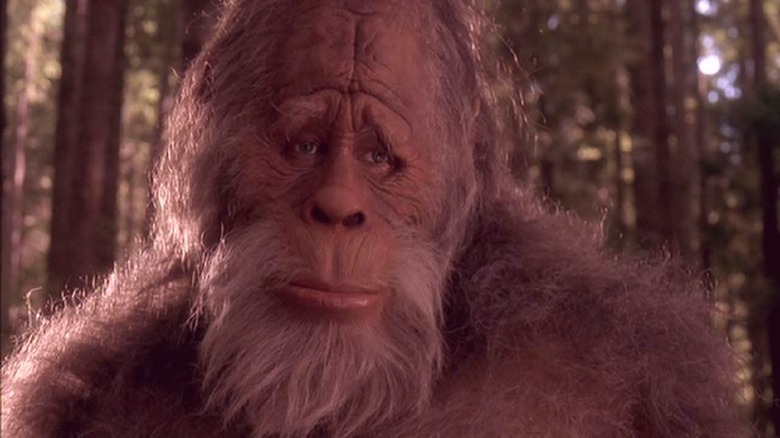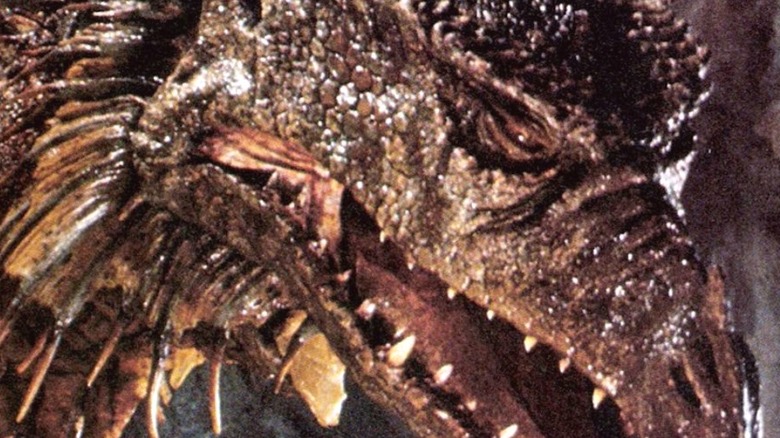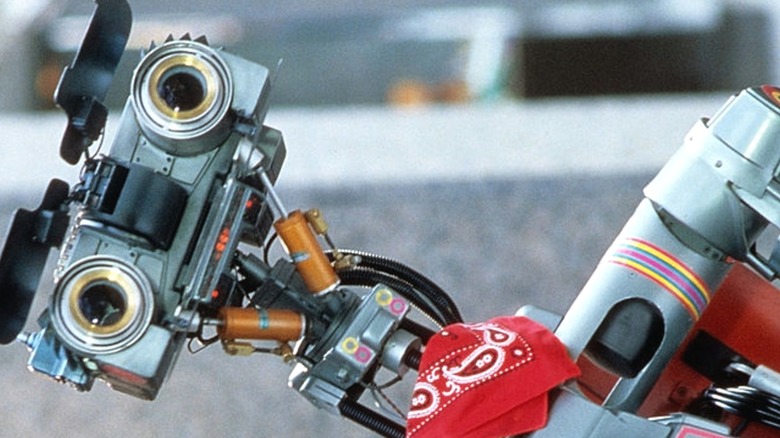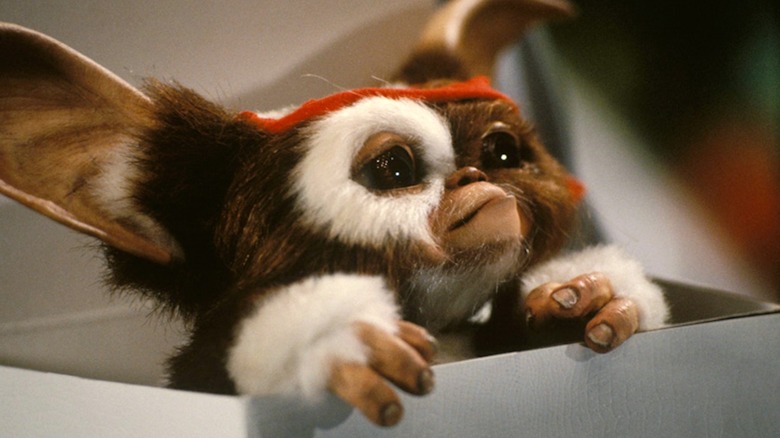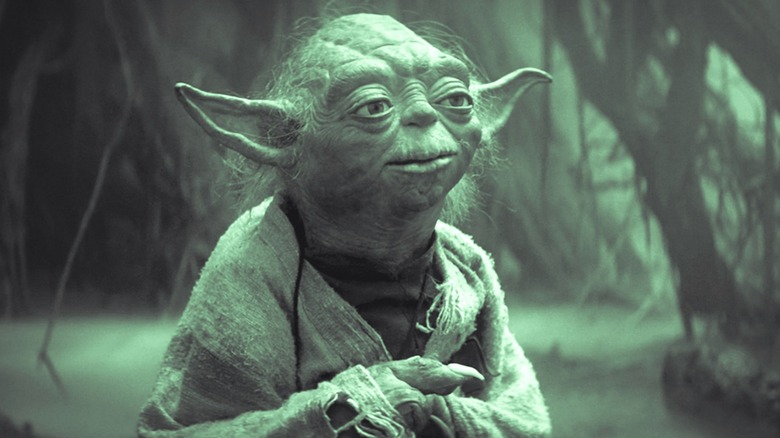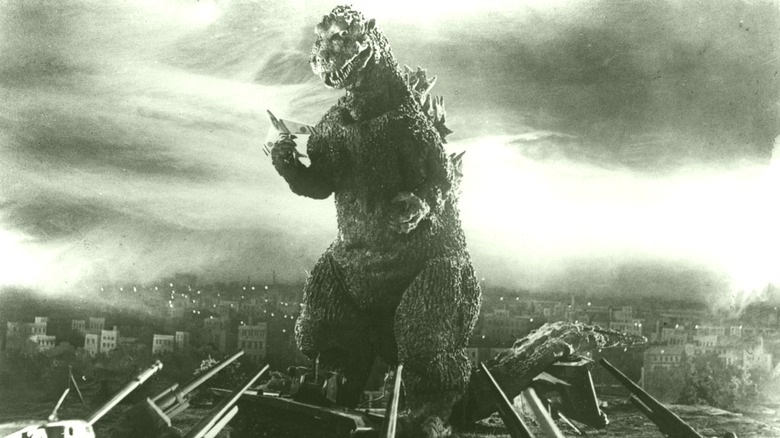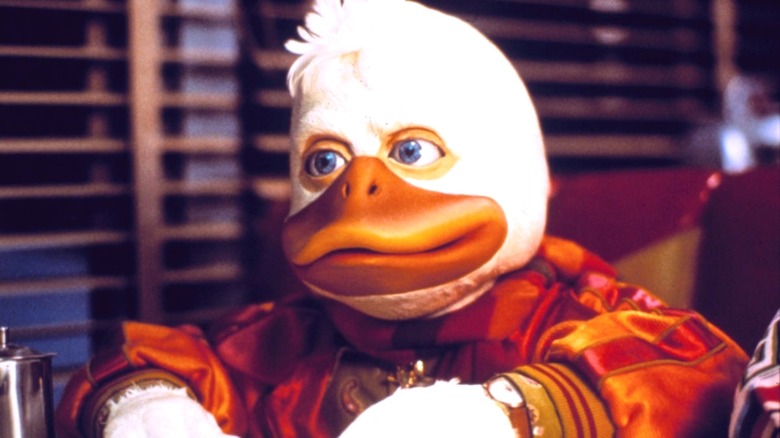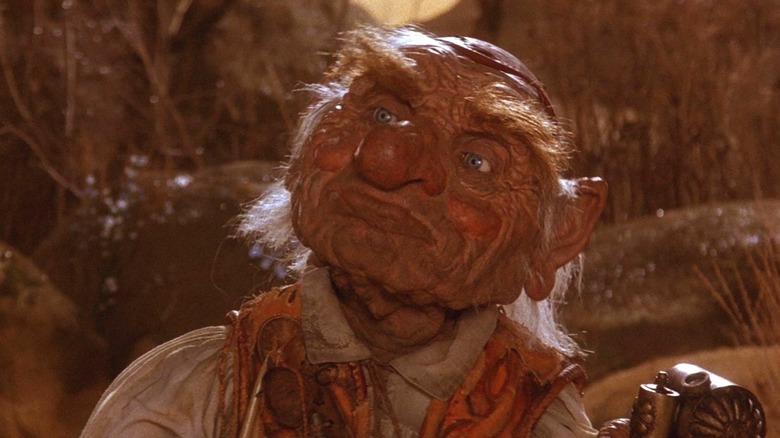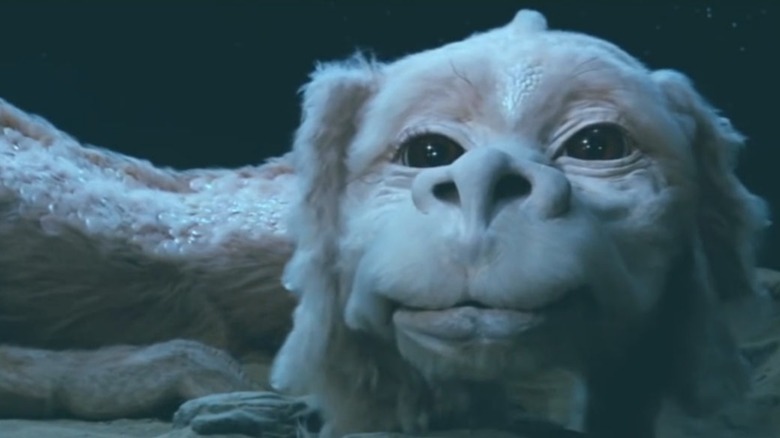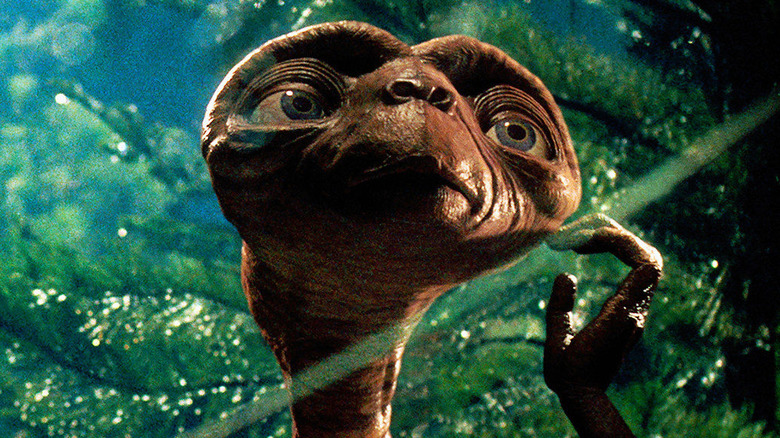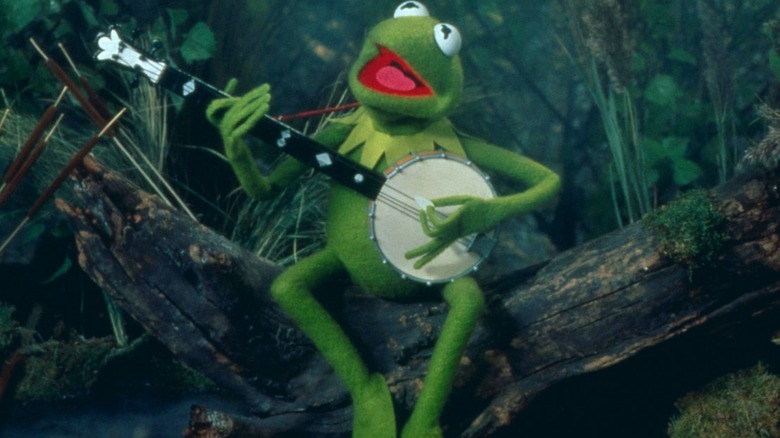Here's What Happened To The Movie Characters From Your Childhood
These days, when filmmakers want to put a monster or something cute on the screen, they use CGI. This isn't always the case — occasionally, a character like Grogu from "The Mandalorian" is made practically, but that's rare. Modern technology has rendered puppetry somewhat obsolete, but before CGI took over, filmmakers and VFX artists came together to create some truly breathtaking characters.
Sadly, most of the movie characters everyone enjoyed watching while growing up haven't survived the test of time. Some were simply discarded when production ended, while others made their way into private collections. If you've got the cash, you could own a piece of movie memorabilia, but it's not cheap. When something from a huge film like "Gremlins" hits the auction block, it's going to cost a lot of money.
Still, some of our favorite characters from the 1970s and '80s do survive to this day. Whether they've ended up in museums, the hands of private collectors, or were left to rot in an airport's unclaimed baggage section for decades, there are a few impressive practical creations still out there. These are some of the most important characters in cinematic history that survived time and indifference.
Bruce from Jaws went from a junkyard to a museum
Few film characters are as important as Bruce. That was the name given to the mechanical puppet shark in "Jaws," and while he's not cute and cuddly, Bruce was responsible for kicking off the summer blockbuster trend when "Jaws" hit theaters in 1975 and became the highest-grossing film of all time up to that point.
Bruce is a complex puppet, and a total of three were made for the film. The reason you hardly see the shark in the movie, however, is partly to increase the tension but also because Bruce didn't work well. When shooting wrapped, all three puppets were destroyed, but after the film became a hit, Universal commissioned a fourth puppet from the original mold. Bruce was hung at Universal Studios Hollywood for 15 years before finding its way into a junkyard.
The junkyard's owner donated Bruce to the Motion Picture Academy Museum in 2016, where it underwent restoration. Hanging out in a junkyard for a quarter century didn't keep Bruce looking fresh, so the museum brought in Greg Nicotero, best known for his work on "The Walking Dead," to repair him. Bruce was restored to his former glory and now hangs on display at the museum to welcome visitors above the main escalator.
One puppet from Mac and Me survived
Not long after "E.T.: The Extra-Terrestrial" proved that cute little aliens could score big at the box office, other studios tried to emulate that success. Most efforts failed, and "Mac and Me" certainly qualifies as a failure. The 1988 film was torn apart as one of the worst movies ever made, but while it's not a great movie, it does hold a place in popular culture, thanks to a running gag between Paul Rudd and Conan O'Brien.
Their ongoing joke has Rudd showing a clip every time he appears on O'Brien's show, and as a result, more people are aware of this horrible film, which is now considered a campy cult classic. Regardless of how bad the movie is, it does feature an adorable little alien puppet, and when filming wrapped, one survived.
The only surviving Mysterious Alien Creature (MAC) that still exists is in the hands of Hollywood History. The company procures and sells movie memorabilia to collectors, though it doesn't appear that anyone has purchased the MAC puppet. According to Hollywood History, their MAC was used as a stand-in when the main puppet wasn't needed.
Chucky from Child's Play sold at auction for $159,375
Back in the 1980s, the success of the Cabbage Patch Kids inspired screenwriter Don Mancini to write a script about a killer doll. The doll, which is reminiscent of the My Buddy line of dolls, became Chucky, the antagonist in "Child's Play." The first film came out in 1988, and while it's a bit cheesy, it's also a cult classic.
Today, the "Child's Play" story has expanded into a massive franchise. Chucky is the epitome of evil, and despite appearances, he's not a cute and friendly little companion — he's a murderous psychopath bent on slaughtering anyone and everyone around him. While there have been many Chucky props from various films in the series, one still exists from the original "Child's Play."
A carrying prop, which was used in the film before Chucky switches from adorable doll to psychotic killer, is available on Heritage Auctions. If you want to add Chucky to your collection, it will set you back at least $159,375. It last sold in March 2024 for $106,250, so if you've got the money and are okay placing this possessed demonic doll in your home, you can own an original Chucky — just keep him locked up.
Harry from Harry and the Hendersons was sold at auction
"Harry and the Hendersons" is a 1987 comedy about a family that finds a sasquatch they name Harry. The film is notable for Harry's design, which incorporated puppetry, animatronics, and a stunt performer inside a suit. The puppetry involved moving the various parts of Harry's face in unison to make him appear more lifelike, and the results won legendary makeup FX artist Rick Baker one of his seven Academy Awards for Best Makeup.
Best known for his work on "An American Werewolf in London," Baker created multiple heads, costumes, hands, and feet for the film, but not every piece of Harry survives to this day. Two auctions surfaced online in 2015 and 2022, with the first involving a head, hands, feet, and muscle suit. That auction closed for $10,200, which was higher than the $6,000 estimate.
The 2022 auction was for Harry's stunt head, which was used for action shots in the film. It was designed without a nose, so one was designed along with the head's restoration. That auction ended at $8,125, which was also higher than its estimate of $7,000. There may be more Harry parts out there, but they're likely in private collections.
Vermithrax Pejorative from Dragonslayer was listed at auction
Long before digital VFX artists brought dragons to life via CGI, filmmakers had to rely on a variety of methods to produce screen-worthy winged beasts. While there have been many movie dragons throughout the years, the most notable from the days before CGI is Vermithrax Pejorative. Besides having the coolest name in all of cinema, Vermithrax is the dragon from 1981's "Dragonslayer."
Director Guillermo del Toro — no slouch when it comes to creating fantastic monsters — told Coming Soon that Vermithrax Pejorative was his favorite cinematic dragon and "one of the most perfect creature designs ever made." Vermithrax was created using go-motion, model work, and puppetry, with the idea being that viewers would see as little of the beast as possible to hide the mechanics that brought it to life.
It's unclear what happened to all the puppets, full-size feet, neck, and head, but at least one model survives. Propstore Auction in the U.K. listed a slightly decayed stop-motion miniature dragon puppet from the movie. It's one of two created for flying scenes, and was listed for sale for between £30,000 – £50,000 ($38,500 – $64,000). The model hasn't sold, so some lucky collector may still one day add him to their archives.
Johnny 5 from Short Circuit went to the highest bidder
Back in the 1980s, movies seemingly included robots wherever they could, but they weren't all intent on killing all humans like the Terminator. Some robots were lovable characters, and that's where Johnny 5 comes into play. "Short Circuit" and its sequel introduced the world to an amiable and adorable military drone-turned-sentient-bot, and he quickly became a beloved member of popular culture.
Fans have built replicas of Johnny 5, who's also emblazoned everything from T-shirts to lunchboxes. Of course, getting to own the real thing is the ultimate dream, but it wasn't necessarily attainable for everyone. The character in the 1986 film was realized via full-size puppets with remote-controlled animatronic elements, one of which sold at auction in November 2022.
The auctioned Johnny 5 was in excellent condition, with some age-related wear and tear. It lost some functionality since it was used in the movie, but that didn't keep some fans away. When the auction closed, it did so for £287,500 ($369,000), which was considerably more than the estimated price of £160,000 ($205,400). While the prop isn't as lifelike as it was in the movie, it remains an important part of cinematic history.
Gizmo from Gremlins was sold at auction
Few creature characters from the 1980s are as adorable as Gizmo from "Gremlins." The diminutive critter with big brown eyes was designed and created by Rick Baker, who also created the Gremlins used in the 1984 film. Gizmo was so cute that his look inspired the creation of the Furby, which was an animatronic talking toy.
Gizmo is both adorable and the harbinger of doom because, once you get him wet, he pops out multiple "offspring." Gizmo's spawn eventually transform into nasty Gremlins once they're fed after midnight. Despite this, it's still hard to see Gizmo as anything but lovable. He was made into toys of all sizes, and there was a special Furby that looked exactly like him, which was used in a marketing campaign.
It's not clear what happened to the original Gizmo, but the Gizmo from "Gremlins 2: The New Batch" was one of several animatronic props from that film that went up for auction in 2022. While the screen-used Gizmo was expected to bring in as much as $120,000, it ended up selling for $137,500.
Yoda from The Empire Strikes Back is in a museum
When Jedi Grand Master Yoda first appears in 1980's "The Empire Strikes Back," he looks surprisingly lifelike. Although Yoda is rendered via CGI these days, he was initially a puppet controlled by legendary puppeteer Frank Oz, assisted by a bunch of creative people from "The Muppet Show."
Yoda was primarily a complex hand puppet made from a mold of Oz's arm and hand. It featured a removable head skin that could be replaced as each one wore out. One such skin found its way to The Prop Gallery, and while it looks kind of horrifying, it's an original skin mounted onto Yoda's head for the movie, so it's a historic prop with a lot of character.
It's also not the only surviving part of Yoda. A Yoda figure is in the collection at the Museum of Moving Image, though it's not currently on display. The museum's Yoda was cast from the original mold, though it was made for the museum and wasn't used in the film. Additionally, one of Yoda's puppet hands was sold for $21,250 in June 2022.
Godzilla is proudly displayed at Toho's museum in Japan
Few movie monsters are as recognizable as Godzilla, who was first introduced in the 1954 movie "Gojira." Today, Godzilla is created using CGI, animation, or a combination of the two, but that's not how it used to be. For decades, whenever Godzilla graced the silver screen, he did so via an actor inside a large suit, giving birth to the special effects genre of suitimation.
Godzilla destroyed complex miniature city sets while fighting other actors in suits, firmly solidifying his place in film history. Toho has produced "Godzilla" films in Japan since the monster's inception, and the production studio is in possession of many of the Godzilla suits used across his dozens of films; each is different in slight or exaggerated ways.
Unfortunately, a large number of Godzilla suits were either destroyed or decayed beyond recognition years ago. Toho Studios' collection resides at The Eiji Tsuburaya Museum, though the oldest suit still in existence on display is from the 1994 film, "Godzilla vs. SpaceGodzilla." Newer suits and recreations of the original are also in the museum's collection, including one recreation of the 1954 suit from the short film "Dream Challenge: Godzilla Appears in Sukagawa."
Howard the Duck's head and hands made it to the block
Believe it or not, the first Marvel film wasn't "X-Men" or even "Blade" — it was 1986's "Howard the Duck." The film is objectively terrible, and while it was a total flop on most levels, one place it succeeded was the depiction of its star. Howard was made using a combination of puppetry, animatronics, and an actor in a suit.
Several people came together to perform the character, who is arguably the most impressive part of "Howard the Duck." While that's not saying much about a movie that's universally panned, Howard remains an impressive feat of engineering and acting. The suit's complexity resided in the head, as most of the rest of the character was controlled via the actor inside.
While the disposition of every constructed suit piece is unknown, one set was sold at auction in 2022. The auction was for the gloves, neck, and animatronic costume head. None of the pieces sold at auction were in good condition, and the look on Howard's face is truly terrifying. Still, it's movie memorabilia, so it didn't sit on the auction block for long. Howard's head and hands sold for $1,375.
Hoggle from Labyrinth got lost in unclaimed baggage
Jim Henson came together with George Lucas in 1986 to create "Labyrinth," a musical fantasy film starring Jennifer Connelly and David Bowie. The film bombed upon release, but quickly became a cult classic that is widely beloved today. "Labyrinth" featured numerous Muppets, puppets, and animatronic creations, as well as people in complex, highly sophisticated suits. One of the main characters, a creature called Hoggle, was operated by five people, including the suit actor and four puppeteers off-camera.
Hoggle was lost in transit after filming ended, and he was pretty much forgotten. He remained lost until he was discovered in unclaimed baggage by an airline employee and sent to the Museum of Unclaimed Baggage in Scottsboro, Alabama in 2022. The state of the animatronic costume head was deplorable: it had all but rotted away, leaving his inner electronic and mechanical parts exposed. Fortunately, Hoggle was restored to his cinematic appearance and placed on permanent display at the museum, among other items from the film.
Falkor from The NeverEnding Story wound up in a museum
"The NeverEnding Story" tells the tale of Bastian, a young boy who skips school after arriving late and decides to hole up and read a book he recently stole. As he reads, the adventure unfolds onscreen, detailing Atreyu's quest to stop the Nothing from destroying the world of Fantasia, where all of humanity's dreams are a reality.
The 1984 film utilized numerous special effects methods to bring its characters to life, including robotics and puppetry. The most recognizable character from the film is undoubtedly Falkor, the luckdragon who rescues Atreyu and aids him throughout his adventure. Falkor was rather large and cumbersome, so he didn't move on his own and couldn't be made to walk about, which is why Falkor is usually seen lying down when he's not in flight.
In fact, it's Falkor's size that ensured he stuck around after filming wrapped. If you want to see the original Falkor, you can do so — and you can even ride it. Falkor resides at Bavaria Films, a German studio in Munich, which is also where much of the movie was shot. Falkor and a bunch of set pieces and props from the film are on display in surprisingly pristine condition.
E.T. was sold at auction
Of all the movie characters created in the 1980s, none rise to the same level of fame as E.T. The title character from "E.T.: The Extra-Terrestrial" is beloved worldwide, and it's not hard to understand why. He's cute with big emotive eyes, and he's got a heartwarming personality. The film was an incredible success, so E.T. popped up on everything from T-shirts and posters to comics and one of the worst video games ever created.
E.T. was created by visual effects wizard Carlo Rambaldi using a variety of methods, including puppetry, animatronics, and a person in a suit. He was incredibly complex and was considered state of the art in 1981. The main E.T. puppet used in the film had 85 points of articulation, allowing it to show a wide range of emotions.
The original prop used in the film was sold at the "Icons and Idols: Hollywood" event at Julien's Auctions in 2022. The auction closed at an astoundingly high price of $2.56 million, which shows just how important a character E.T. is in the history of film. A maquette used to get director Steven Spielberg's approval on the design previously sold for $125,000.
Kermit the Frog found his way to the Smithsonian
Ask a random person on the street who the most famous puppet in the world is, and there's a good chance they'll say "Kermit the Frog." Jim Henson created and performed Kermit in 1955, later using him in many of his shows. Kermit was featured on "Sesame Street," and became an even bigger star after Henson made "The Muppet Show" into a hit.
Kermit went on to appear in numerous movies, advertising campaigns, and television series. It would be hard to argue that he's not the most important frog in the history of film and TV. Because of his importance to 20th century puppetry and popular culture, Kermit holds a place of high honor where movie props and characters are concerned.
Kermit currently resides in the Smithsonian National Museum of American History. The Kermit on display is the original puppet from the "Sam and Friends" TV show, which aired from 1955 to 1961. While Kermit is the most famous Muppet residing at the Smithsonian, he's not the only one. Henson's family donated a plethora of puppets from "Sam and Friends" to the museum, where they're preserved for future generations to enjoy.
